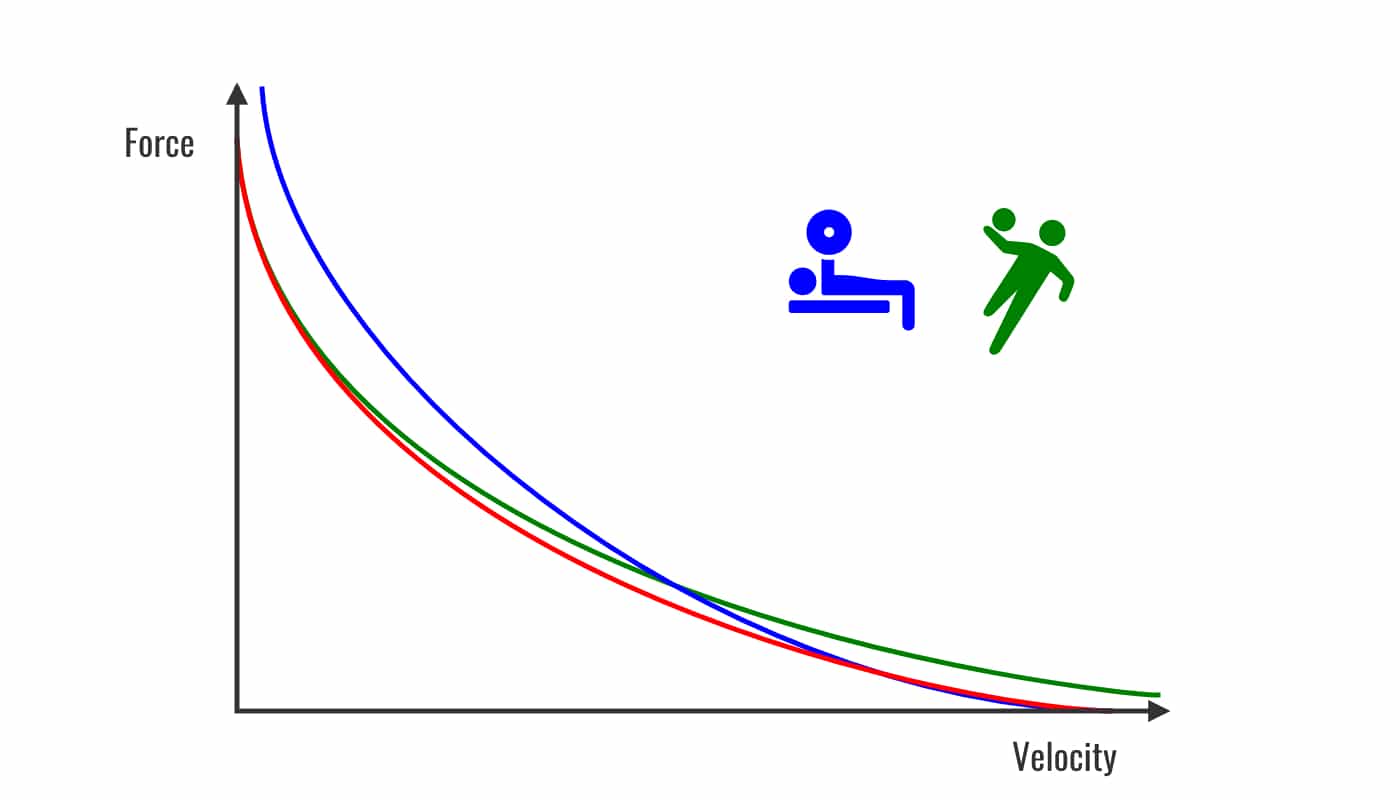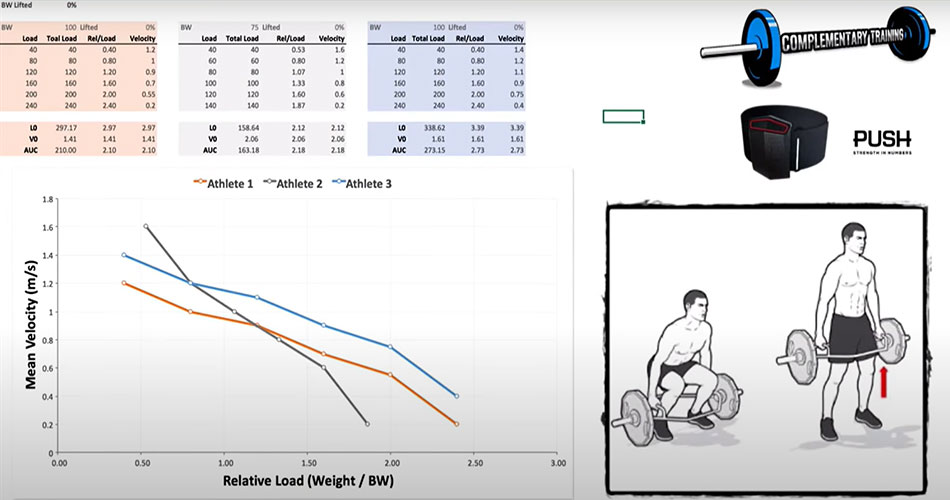Force-Velocity Curves – the Good, the Bad, the Ugly
The force-velocity relationship is central to many theories of training, as well as in various practical approaches. For instance, in Zatsiorsky’s “Science and Practice of Strength Training” (1) — which, in my opinion, is one of the few Eastern European manuals that’s actually comprehensible by us ‘westerns’ — there is a pretty figure (see below) which shows that various types of training have various effects on an athlete’s force-velocity curve.

Makes sense, right? Back in 1938 Hill had already demonstrated that muscles abide this hyperbolic law: the higher the resistance a maximally stimulated muscle has to overcome, the slower it is able the shorten (2). And considering that adaptations are specific, maximal strength training probably has the most impact on the left side of the curve, whereas more explosive work tends to impact the curve more to the right. Still, we need well-rounded athletes, so we should provide “stresses that allow for a more complete adaptation to occur across the entire force-velocity curve” (3).
It’s a nice story. But I have problems with it. Let me tell you why.
The good
Very well, let’s start on a positive note for a change. There are certain circumstances in which a force-velocity profile could be a very useful tool for analyzing and improving a specific movement pattern. The main context that jumps to mind (pun intended) is that of two-legged vertical jumping, as demonstrated by Samozino & Morin and colleagues (4). They have also provided evidence for force-velocity profiling being useful in sprinting (5), but admittedly I haven’t looked into this much yet. Short and sweet, right?
The bad
Now let’s start the rant. The aforementioned researchers have quite clearly stated that an individual’s force-velocity profile as obtained by jump squatting, should not be extrapolated to movements other than vertical jumping. Nevertheless, many in practice and even in research seem to have completely missed this message.
For instance, there is a peer-reviewed publication in which the authors make broad-sweeping statements about force-velocity capabilities of very different kinds of athletes, purely based on jump squat measurements (6). Many of those athletes rarely, if ever, jump (vertically) though… And on a side note, in the introduction they refer to a study by Maarten Bobbert (which I will refer to in a minute as well) while more or less stating the opposite of what he meant. Moral of the story: even peer-reviewed studies may be of very bad quality.
The ugly
But unwarranted extrapolation of the force-velocity curve has been taking place on a grand scale since long before the work of Samozino & Morin. Let’s take a peek again at the figure that I adapted from Zatsiorksy’s book. Here the author assumes — like most do — that the force-velocity relationship for complex movements (running, jumping, pushing, pulling, etc.) is shaped hyperbolically, just as it is for isolated muscles (as determined by Hill). In fact, however, the force-velocity relationship for many complex movements is quasi-linear (7–9).

But who cares, right? That’s just a minor detail: an increase in speed is still associated with a decrease in force. Unfortunately for those who don’t like to look past the end of their noses, it’s much more than a detail though. The discrepancy reflects the fact that there is far from a one-to-one relationship between the contractile capacity of muscles (as determined by Hill) and the power output of complex movements.
In fact, the contractile capacity of muscles only partly determines the power output of complex movements. Segmental dynamics probably play a (much) more important role (10,11). These dynamics refer to the fact that in most complex movements the rotations of body segments are transformed into translation (of the body’s center of gravity or the end effector). And especially when movement velocities get higher, these transformations result in a lot of muscle power output being ‘wasted’.
FYI: For proponents of the ‘overload principle’ it should be of interest that due to segmental dynamics — in a leg press task — muscle power output peaks around 15% of 1RM, while external power output peaks around 50% (10). And from a physiological point of view, only muscle power output matters…
If we truly wish to understand complex movements, we have to stop extrapolating phenomena such as Hill’s relationship beyond their original context. Rather, we have to start figuring out (among other things) how the central nervous system takes segmental dynamics into account when coordinating these movements (12).
My point is that THE force-velocity curve of — for example — the lower leg musculature, does not exist. After all, the output (force, velocity, power, etc.) of a complex movement is strongly dependent on the specific neural control of involved muscles. Thus, you always have to take into account the specific movement pattern that you wish to improve. Just squatting with a variety of loads to “allow for a more complete adaptation to occur across the entire force-velocity curve” and expecting transfer to all kinds of movements is delusional.
Summary & Implications
- Force-velocity profiling could be a useful tool in the specific contexts of two-legged vertical jumping and sprinting.
- For complex movements, there is no such thing as THE force-velocity curve; it is specific to each particular movement.
- …and only in part determined by Hill’s relationship for isolated muscles (which is rarely relevant in practice).
- Precise (and robust) coordination of sport-specific movements is key.
So yes, I generally recommend training with a strong focus on the actual movements that occur in the particular athlete’s sport. Of course, in order to increase the contractile capacity of muscles there still might be a case for more traditional resistance training. But is this a strong case? Is it worthwhile? That’s another story altogether. I shared some of my thoughts here (scroll down to “A lifeline for strength training?”).
Final musings
The literature on strength training emphasizes the importance of various ‘force-velocity’ and ‘force-time characteristics’. These ‘parts’ are said to determine sports performance, just like wheels determine the workings of a clock. This (implicit) mode of thinking — also known as mechanicism — has a fundamental flaw however: mechanical systems cannot control themselves. Therefore, mechanicists have to resort to dualism, which becomes evident in statements that not only strength is important, but also “the ability to use this strength through coordinated body movements” (13).
Complex systems — such as the human body and movement — are much more than an assembly of independent parts. We have to think more in wholes from the get-go. In the whole of human movement, the central nervous system plays a key role. But while viewing an authoritative review of “The Importance of Muscular Strength in Athletic Performance” (13), a ‘Ctrl + F’ only yielded 3 hits for “neural” and exactly 0 for “central nervous system”, “brain” and derivatives. Make of that what you will…
References
- Zatsiorsky, V. M. & Kraemer, W. J. Science and Practice of Strength Training. (Human Kinetics, 2006).
- Hill, A. V. The heat of shortening and the dynamic constants of muscle. Proceedings of the Royal Society of London. Series B, Biological Sciences126, 136–195 (1938).
- Soriano, M. A., Jiménez-Reyes, P., Rhea, M. R. & Marín, P. J. The Optimal Load for Maximal Power Production During Lower-Body Resistance Exercises: A Meta-Analysis. Sports Med.45, 1191–1205 (2015).
- Jiménez-Reyes, P., Samozino, P., Brughelli, M. & Morin, J.-B. Effectiveness of an Individualized Training Based on Force-Velocity Profiling during Jumping. Front. Physiol.7, 677 (2016).
- Morin, J.-B. & Samozino, P. Interpreting Power-Force-Velocity Profiles for Individualized and Specific Training. Int. J. Sports Physiol. Perform.11, 267–272 (2016).
- Giroux, C., Rabita, G., Chollet, D. & Guilhem, G. Optimal Balance Between Force and Velocity Differs Among World-Class Athletes. J. Appl. Biomech.32, 59–68 (2016).
- Vandewalle, H., Peres, G., Heller, J., Panel, J. & Monod, H. Force-velocity relationship and maximal power on a cycle ergometer: Correlation with the height of a vertical jump. Eur. J. Appl. Physiol. Occup. Physiol.56, 650–656 (1987).
- Rahmani, A., Viale, F., Dalleau, G. & Lacour, J.-R. Force/velocity and power/velocity relationships in squat exercise. Eur. J. Appl. Physiol.84, 227–232 (2001).
- Cormie, P., McCaulley, G. O. & McBride, J. M. Power Versus Strength–Power Jump Squat Training: Influence on the Load–Power Relationship. Med. Sci. Sports Exercise39, 996–1003 (2007).
- Bobbert, M. F. Why is the force-velocity relationship in leg press tasks quasi-linear rather than hyperbolic? J. Appl. Physiol.112, 1975–1983 (2012).
- Bobbert, M. F. Effect of unloading and loading on power in simulated countermovement and squat jumps. Med. Sci. Sports Exerc.46, 1176–1184 (2014).
- Bobbert, M. F. & van Ingen Schenau, G. J. Coordination in vertical jumping. J. Biomech.21, 249–262 (1988).
- Suchomel, T. J., Nimphius, S. & Stone, M. H. The Importance of Muscular Strength in Athletic Performance. Sports Med.46, 1419–1449 (2016).











Responses